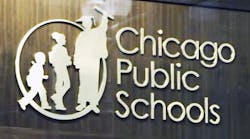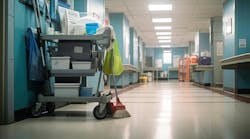Can schools provide a cleaner, more healthful school environment by simply combining heat and water?
Yes. Schools can be prime beneficiaries of European steam technology. The Centers for Disease Control and Prevention estimates that 164 million school days are lost annually because of illness; effective cleaning and disinfection in schools and universities could reduce that number.
Using the elements
Steam vapor systems use only tap water with no chemicals added. Low-pressure (12 psi to 65 psi) steam vapor sanitizes and deodorizes. This process can then be used safely in many situations, but is especially suited for restrooms and food-service areas. These areas require maximum disinfection and sanitation, have many hard-to-reach areas, and may expose people to chemical disinfectants. The risk of chemical exposure is believed to be a factor in many allergy-related childhood diseases and ailments.
Heat often is the only ingredient used to sterilize surgical instruments, and water is the best solvent and rinse agent to remove soil and chemical residues. The combination of heat and water in a steam vapor system enables schools to avoid chemical-based cleaning regimens. Those chemicals can leave residues and result in biofilm development that can harbor additional bacterial growth on seemingly “clean” surfaces. Biofilms are highly resistant to almost all germicides, including bleach, but hot steam vapor penetrates and removes them. Effective steam vapor cleaning also emulsifies grease and oil, and removes even embedded contaminants from surfaces.
Steam vapor systems use tap water (or filtered water in hard-water areas) that is heated to 300°F inside the machine's boiler to form low-moisture steam vapor. As it is applied to the surface (with insulated tools to protect workers), the steam vapor reaches temperatures of between 215°F and 230°F. The “dry” (typically 6 percent moisture content) steam vapor penetrates into surface micro-pores, and reaches bacteria and mold that are not killed by surface-applied chemical disinfectants.
A safe consideration
Steam vapor systems also can improve workers' health and safety, cleaning efficiency and a school's maintenance budget.
By eliminating chemical use, workers avoid exposure to compounds that may cause eye and skin irritation or chemical burns. Because a steam vapor system uses only tap water, it requires no material safety data sheets (MSDS).
For cleaning jobs in confined areas, on overhead surfaces, or in places with the potential for exposure to bloodborne pathogens, workers must use personal protective equipment.
When schools reduce exposure to hazardous chemicals and related occupational hazards, the cleaning staff gains time as well as safety. Less time is spent scrubbing, cleaning hard-to-reach areas or slipping on wet floors. Steam vapor systems also leave little water residue. Newer steam vapor systems disinfect in 7 seconds, instead of the typical 10-minute “wet” dwell time required for chemical disinfectants. Surfaces are clean, dry, odor-free, disinfected and available for use more quickly.
Operators must be trained properly to use the equipment efficiently and safely. The investment in training can translate into an efficient and simplified cleaning regimen, which can yield a cleaner and safer facility.
Several factors can affect a school's cleaning budget (see sidebar above). Facilities that have converted from traditional cleaning methods spend less on chemicals and replace equipment less frequently. New designs that eliminate scaling and mineral buildup extend the life of the steam generator. Brushes and accessories, however, do wear out with use and may need replacement.
Unlike acid-based cleaners, steam vapor will not degrade grout or stainless steel. The process can prolong the life of building components — a long-term cost savings.
Hoverson is a principal of Advanced Vapor Technologies, Edmonds, Wash.
Steam vs. traditional
A test conducted at the University of Washington's Odegard Undergraduate Library, which is used by as many as 15,000 students daily, provides evidence of the benefits of a specialized steam vapor system used by trained custodians.
Over six weeks, custodians used the system to deep clean and sanitize restrooms (including floor tile and grout, wall areas, baseboards, fittings and fixtures). Cleaning times and degree of cleanliness were recorded and contrasted with traditional cleaning methods. Cleaning time was reduced (42.5 minutes vs. 46 minutes) with the steam vapor system. Custodians attributed the time savings to less squatting and stooping to clean hard-to- reach places behind toilets, and under sinks and urinals. With no residual water on floors, drying time also was reduced.
Swab tests compared the degrees of cleanliness of the two cleaning methods. Steam cleaning resulted in cleaner fixtures and surfaces. Steam-cleaned faucet handles and towel dispenser handles, for example, were more than 10 times cleaner than those cleaned with traditional methods. The steam vapor method also eliminated workers' exposure to chemicals and resulted in a “pride of accomplishment factor” for the custodians.
NOTABLE
300°F
Temperature of water used in a steam vapor system.
10
Number of minutes required for the typical dwell time of chemical disinfectants.

